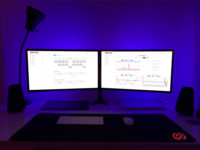The “It” Factor
By JOANNA COSGROVE
New beverage packages tap into consumer lifestyles to
heighten brand experiences
When readying a new
beverage for launch, manufacturers often spend as much time devising the
packaging as they do the beverage itself — and if they don’t,
they ought to. Packaging plays a crucial role in a marketing plan: summoning prospective customers to the retail shelf,
and enticing them to buy. In the beverage segment, shelf and cold case
space is limited and gaining an edge with packaging can be paramount to a
brand’s success.
The Coca-Cola contour bottle is an iconic brand symbol
that has been famously immortalized in the art world, most notably by
artist Andy Warhol. Coke’s most recent artistic foray is a new series
of impact extruded aluminum bottles designed to reflect the creativity of
artists from Europe, Asia, South America, North America and Africa, dubbed
M5 (“Magnificent 5”).
The aluminum bottles, supplied by Exal Corp., are the
first to incorporate full-body shaping — a key development that
allowed Coca-Cola to create its signature contour bottle, says Scott
Biondich, Coca-Cola’s global director of packaged soft drinks. He
credits the Italian company Frattini S.p.A. for developing the shaping
process, adding that the printing is done on
the bottles while they are in cylindrical form, prior to shaping.
“The challenge for this project was to reinvent
a bottle with the benefit of the science and technology of the 21st
Century, yet keeping our unique Coca-Cola shape and our heritage of
collaboration with art and culture,” says Marc Mathieu, senior
marketing vice president, core brands at Coca-Cola.
Segmentation work led the bottle’s development
team to the world’s top nightclubs and bars. “We found that
this segment had a great deal of uniformity across the globe in terms of
their likes: music, fashion, art, etc.,” Biondich recalls. “The
M5 aluminum bottle in the nightlife channel, with the incredible graphics,
fit perfectly. The graphics change every two to three months so the bottles
stay fresh with this trendy set, and we also incorporated fluorescent inks
that glow under blacklights. The objective of the project was to create an
experience; there is much more to it than a shaped bottle with beautiful
graphics.”
The M5 bottle experience launched late last summer in
several global markets and will debut in a number of additional markets
this year.
Wine goes PET
Innovative packaging is playing an increasingly
important role in the growing wine category as consumers seek greater
convenience, variety or an easy way to try something new. In January, Ball
Corp., Broomfield, Colo., presented both its stock and custom PET wine
bottles, which were designed to combine the premium look and feel of glass
with the modern convenience of plastic. The bottles are positioned as a
vehicle for brand owners who want to target usage occasions like travel and
outdoor venues where glass is not allowed.
“Sales of single-serve, 187-ml. wine bottles
grew nearly 20 percent last year,” says Jerry Rosenow, Ball’s
national wine category manager. “The size is just right for
today’s growing portion of smaller households and consumers for whom
a 750-ml. bottle is just too much for the occasion.”
Ball designed a custom 187-ml. PET wine bottle for
Sutter Home Winery that preserves the look of the existing Sutter Home
glass container. The winery launched four varieties in the 187-ml. PET
bottles into select markets last fall and continues to expand
distribution. “We already had a single-serve size in our 187-ml.
glass bottles and believed that adding PET would only increase the level of
convenience for consumers and expand our package mix in line with market
demands,” says Wendy Nyberg, senior director of marketing for Sutter
Home.
Ball designed the Sutter Home bottles to run on the
winery’s existing glass lines in order to minimize the need for
changing parts and simplify filling. “The transition into PET has
been very smooth overall,” Nyberg says. “We have had great support from Ball throughout the development,
testing and production process.”
On-demand mixing
In addition to its PET wine bottles, Ball also
developed a 16-ounce FreshCan that has found a niche in the healthy
beverage sector. The FreshCan contains a plastic Wedge device that stores
vitamin and mineral supplements separately in a dry state inside the can.
The mixing process is initiated with the tab of the can is pulled, which
changes the pressure inside the can, causing the Wedge to open and release
its contents into the beverage.
Defense Effervescent Supplement, a beverage from Brain
Twist Inc., is an immune-boosting drink packaged in the FreshCan. Available
in orange and lemon-lime flavors, Defense contains vitamins, minerals and
throat-soothing pectin and is marketed as a defense against germs like
those that cause colds and flu.
According to the company, the benefit of the new
package is preserving the efficacy of vitamins and minerals. The
ingredients, it says, can become unstable when mixed with water, and the
longer they stay on the shelf or are exposed to light, the more the
vitamins and minerals can degrade.
The notion of on-demand beverage mixing also proved
intriguing to Ipifini Inc., Natick, Mass., which developed a futuristic
Programmable Liquid Container technology, using its Innovation Engine
technology.
Ampoule-like “buttons” on the surface of
the beverage container are pre-filled to allow consumers to select which
variations they’d like to dispense into the base liquid in the
container. For example, a cola bottle could be outfitted with buttons for
lemon, lime, vanilla and cherry flavors, which would allow for 32
combinations of soda.
Ipifini’s founder and president, Tod Woolf, says
consumer demand for variety within a product line has generated a
proliferation of products with different additives. “The Programmable
Liquid Container Technology is applicable to any liquid product with
multiple varieties,” he says. “This technology simplifies
manufacturing, distribution and sales by allowing a single container to
replace a series of product varieties. The technology also allows consumers
to select their desired variation at time of use.” BI

